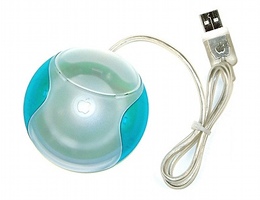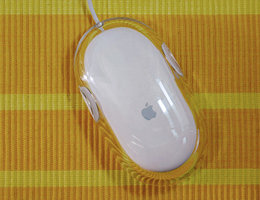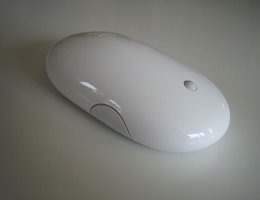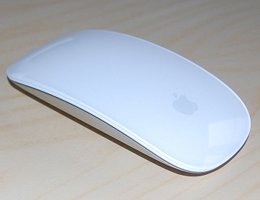Apple hasn’t had the best track record in recent years for making one of the most basic of Personal Computer input devices - the humble mouse. It all seemed to go off the rails for them with the “Hockey Puck” in 1998 whose round shape and size made it difficult to use (however stylish it was intended to be). Apple came back with the Apple Pro Mouse which was a less stylish and more elongated version of the Hockey Puck in 2000. It still was only one button (although the whole mouse was the button) when competing mice at the time were introducing scroll wheels and side buttons, although it had LED Optical tracking and departed from the problematic and cleaning intensive ball mice of the past. In 2005 they tried the Mighty Mouse which added sensitivity for right-clicking and side-buttons as well as a scroll ball. Whilst the additional buttons were generally well received the scroll ball reintroduced the cleaning problems of ball based mice of the past and within months of use usually the scroll ball became clogged. This time however there was no way to remove the ball to clean it (long a feature in ball mice) which lead many a Mac enthusiast to give up on the mouse entirely.
| Apple Mice | Evolution |
|---|---|
 |
 |
 |
 |
(Top Left: The Hockey Puck Mouse; Top Right: The Apple Pro Mouse; Bottom Left: The Mighty Mouse; Bottom Right: The Magic Mouse)
And the stage is set for the new Magic Mouse - so named due to a copyright infringement brought against Apple for the old name Mighty Mouse. The Magic Mouse borrows multi-touch technology which is now common place in other Apple products: MacBook and MacBook Pro TouchPads, iPod Touch and the iPhone. The application is seemingly unusual at first with the top surface of the mouse convex in shape (unlike the other multi-touch devices by Apple which are all flat) but still supporting multi-touch. A considerable area is sensitive as well, covering from the front edge of the mouse to an imaginary line left-to-right across the mouse roughly through the middle of the Apple logo.
The Magic Mouse then eliminates the scroll ball, also loses the side buttons as well as some weight with the old wireless Mighty Mouse (the wired version is still available and is now renamed the Apple Mouse) weighing in at 134g and the new Magic Mouse at 106g including batteries. It is slightly narrower and longer than its old counterpart and oh yes, it’s only available at the moment in a wireless version. The final bonus is that the Magic Mouse now uses Laser tracking for improved accuracy on even the most stubborn surface and is apparently more frugal on battery life. Like the wireless Mighty Mouse before it, communications between the mouse and the PC are done over Bluetooth.
The body of the mouse is no longer the all plastic construction of old but now sports a brushed Aluminium base and battery cover. Although the subframe inside is still plastic it is now Black which is more in tune with Apples current MacBook Pro and iMac offerings. The top surface is a clear plastic with a white underlay and the grey Apple Logo in the bottom centre makes the whole device undoubtedly more professional looking than its predecessor.
The performance of a mouse can be broken down into several parts and each will be considered in turn: Movement of the mouse pointer [tracking]; Usability of scroll functions [scrolling]; Ease of connection [connect-ability]; and Value for money [price].
Tracking: The accuracy of the Magic Mouse was tested on several different surfaces including: a white melamine desk, a wooden desk, a piece of white paper, brown cardboard, a traditional multi-colour image mousepad, blue cloth (my shorts) and a ruled page from a notepad. The only noticeable loss of tracking occurred when the mouse went over an undulating surface (my leg, a dinted table top) and certainly much better and more consistent tracking than the Mighty Mouse on the same surfaces. The laser tracking is definitely an improvement.
Scrolling: Practically every mouse on the market supports scrolling and the Magic Mouse performs this task exceptionally well. To scroll on the Magic Mouse simply use a single finger tip to touch the mouse and move it in the direction you wish to scroll. The user has the ability to turn on and off “momentum” scrolling (like the iPhone where the faster you flick, the more the screen “rolls onward” after you stop moving your finger) which can take a little getting used to for those unfamiliar with it (momentum scrolling is a Snow Leopard only feature). The mouse handles “near 360” degree scrolling though in my tests I found the mouse interpreted finger movements about 15-20 degrees either side of straight as being straight in the prominent direction. Whilst this is better than the mouse it replaces (scrolling diagonally just doesn’t work properly on the Mighty Mouse) it’s still not true 360 degree scrolling as the advertising would lead some to believe. It’s also a fine point when most other mice on the market can’t scroll up and down at the same time and scroll left or right. There is an unmistakable sense of control and accuracy in the scrolling performance of this device - which is good considering the old model had the cleaning issues that it did. The Magic Mouse top can be cleaned with a simple wipe of a cloth.
Connect-ability: As with the Mighty Mouse the Magic Mouse is wireless however in this case it is currently the only option. Whilst some users will be thankful of the extra spare USB port on their iMac / MacBook Pro / PowerMac the reality is there will equally be those who can’t stand spending money on replacing batteries periodically and the additional weight the batteries add. So far as Bluetooth goes no problems were experienced adding the Mouse running OSX 10.6.2, although for users still at 10.5.8 or 10.6.1 the Wireless Mouse Update 1.0 is required. The connection time seems slightly quicker than the Mighty Mouse but only marginally so. The mouse was also tested about 10 meters away with a direct line of sight to the MacBook Pro test unit without affecting performance. A similar test only 6 meters away though through a wall resulted in a disconnection. For those “couch-surfers” with a bluetooth enabled Mediacentre PC, that could be handy to know but altogether no different to the previous wireless models performance.
Price: Whilst there is no other mouse with touch features like the Magic Mouse, there are plenty of other mice that have bluetooth, laser tracking and scrolling capabilities. The most common/popular competitor in the Magic Mouses class is the Microsoft Bluetooth Notebook 5000. Found on several walk-in stores for only $49, compared to the $99 price tag for the Magic Mouse there is no competition. The Magic Mouse is undeniably quite expensive.
Extras: Unlike other mice where what you see is what you get in terms of buttons and functions, like all other Apple multi-touch devices available at any time a software/firmware update can add/modify functionality of the device touch capabilities. Beyond the scrolling function Apple also supports a two-finger swipe left/right to flick between photos in iPhoto or Forwards/Backwards in your web-browser. The gesture itself is quite unnatural considering one must use the thumb and ring finger to hold the mouse steady whilst moving the index and middle fingers either left or right together. More natural gestures such as two-finger clicking, third button clicking, two or three fingers drawn back towards the hand (easier as the palm of the hand braces the mouse) are left without support by Apple. With such excellent features in OSX like Expose, or even more basic functions like zooming in and out of photos and clearing the desktop are already possible with multi-touch gestures on the MacBook and MacBook Pro it seems almost like an unfinished product in this respect. Fortunately Apple can update it through a software update whenever they like. In the meantime developers are already finding new ways to utilise the Magic Mouse and give it more usability with Better Touch Tool giving a multitude of possible gestures including multiple finger swipes and clicks, though the use must be careful with using some of the swipe functions as they can interfere with those Apple have built in. Another products like JiTouch and MiddleClick have also appeared so Apple will hopefully take notice - if they haven’t already.
In summary the Magic Mouse is stunning in only two ways: when compared to the mouse it’s replacing, and the multi-touch upgradability of the device. In reality there are better mice on the market for consumers interested in ergonomics, gaming, and precision movement but this mouse is arguably not aimed at these applications. As it comes standard with every new iMac most users will likely keep it, and many more power users will keep the Magic Mouse when the Mighty Mouse would have previously been put in the bottom drawer. It’s a step in the right direction Apple, but please remember a wired version and please also unlock your products true potential with a software update soon. Thanks.